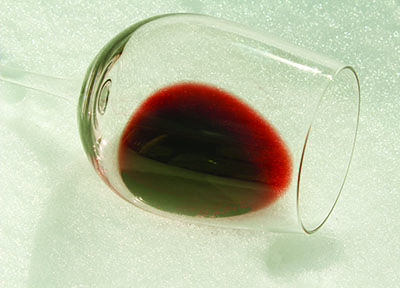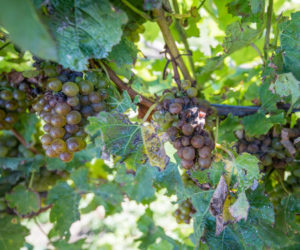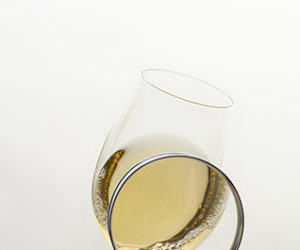
We often read that air (and especially the oxygen it contains) is a wine’s worst enemy. Oxidized wine becomes devoid of subtle and fruity aromas that make it seem tired, as if it is well beyond its apogee (even though it is not). Having lost its finesse and intensity, the wine will also take on a brownish color. As oxidation progresses, the wine will take on a deeper brown color with a sherry-like smell and eventually spoil if untreated. When spoiled, the wine will develop a heavy, white film on the surface and possibly a bluish green mold. This primer will help you understand the harmful effects of oxidation and guide you in preventing, or at least reducing the probability of oxidation.
Understanding Oxidation
Simply stated, oxidation is the result of wine being exposed to air during winemaking, at any time from grape or juice handling to bottling and from an inadequate sulfiting regimen. The more technical explanation is that free oxygen in air causes an enzymatic reaction with oxidases — the oxidizable enzymes, such as tyrosinase (polyphenoloxidase) — found in grape juice resulting in oxidation of aromatic and pigmentation compounds.
Fermentation and vinification compounds found in wines — such as alcohol, acidity, tannins and sulfur dioxide by-products — offer better oxidation protection than musts. Oenologist Emile Peynaud supports this theory in his book “Knowing and Making Wine” (John Wiley & Sons, 1984) by stating that “musts consume on the average two milligrams of oxygen per liter per minute whereas wines take 24 hours to consume the same amount.”
The susceptibility of must to oxidation underlines the extra care required during grape and juice handling. In general, red wines are less prone to oxidation effects because of their higher concentration of phenolic compounds, which inherently ward off hungry oxygen molecules.
The enzymatic reaction also accelerates as temperature increases, which increases oxidative effects and therefore requiring the wine to be stored at a cool temperature, for example around 55 °F (13 °C). Additionally, as pH increases must and wine become more susceptible to oxidative effects. Therefore, low pH wine is better protected and will tend to age better and longer and exhibit more aromas and a livelier color. And remember, the effectiveness of free SO2 from sulfite additions for protecting wine against oxidation (and spoilage organisms) also decreases as pH increases.
10 Ways to Ward Off Oxidation
There are two general recommendations to follow diligently during winemaking: 1) minimize the must’s and wine’s exposure to air, and 2) sulfite judiciously. Following are ten specific reccomendations to avoid oxidation.
1. Transfer Whites Quickly:White musts are most prone to the effects of oxidation and should therefore be immediately transferred to carboys following crushing and pressing operations. White wine maceration is not recommended; otherwise, the wine will turn a brownish color. Be sure to remove berries and grape bunches affected by mold or rot.
2. Adjust the pH: The higher the pH, the more prone wine will be to oxidative effects. If your wine’s pH falls in the ideal range of 3.1–3.6, don’t play with it. To decrease the pH, add tartaric acid crystals before the start of fermentation at the rate of 1 g/L (0.13 oz./gallon) of juice for every 0.1 unit of pH.
3. Use Sulfite: Sulfur dioxide (SO2) is used in winemaking as a preventative against microbial spoilage, but also to reduce the effects of oxidation. And as pH increases, the effectiveness of free SO2 decreases. My rule of thumb is to maintain a nominal free SO2 level in a wine throughout its life until bottling at a value equivalent to 10 times the fraction value of a red wine’s pH, and add 10 for white wine. For example, for a red wine with a pH of 3.4, maintain a free SO2 level of 40 mg/L (ppm). A white wine with the same pH would require 50 mg/L. Use the sulfite calculator at www.winemakermag.com to determine how much sulfite you need to add for the desired free SO2 level.
4. Top Up: One advice that cannot be repeated often enough is to always, always top up your wood barrels or other containers when storing or aging wine. Following the alcoholic fermentation, fill your carboys to leave no more than 3⁄4 inch (1.9 cm) of ullage — the headspace between the surface of the wine and the bung. Then secure the carboy opening with a fermentation lock properly filled half way with water. Most oxidation problems related to inadequate top up involve barrel aging. Wine breathes through the wood and stave/head joints (i.e. all joints between any wood member) of the barrel. As wine evaporates, it is replaced with air. Check the wine level in all barrels at least twice a month and top up to the bung hole using a reserve wine of similar quality.
5. Rack by Gravity: It is often recommended to rack red wine “by splashing.” During racking, wine is allowed to splash at the bottom of the container and at the wine’s surface as the level rises in the container. This softens the wine and can increase the fruit characteristics. White wines should never be racked with splashing because these are more prone to oxidation. As much as possible, rack wine by gravity, as you first learned when you made that first batch of wine. Other mechanical means, such as pumps, which hasten oxidation should be avoided. Many commercial wineries pride themselves on having a gravity flow system, usually associated with higher quality wines because these have not been subjected to any mechanical processing.
6. Avoid Pumps: Unless you handle large volumes of wine where gravity flow is too time-consuming, the use of mechanical pumps should be kept to a minimum, such as in filtering. Mechanical pumps greatly speed up racking or wine transfer operations; however, they tend to dissolve some oxygen in the wine and therefore cause some oxidation. Always look for alternatives. For example, instead of (mechanical) pump over of wine during red wine maceration, punch down the cap. It is much gentler on the wine.
7. Use Closed Systems: When possible, use a closed system for winemaking operations to minimize wine exposure to air. For example, when filtering, use a vacuum pump to draw air out of the receiving carboy instead of using a normal pump.
8. Use Ascorbic Acid Diligently: Ascorbic acid (vitamin C) is an ingredient often used in home winemaking for its antioxidant properties. However, its use is not well understood. Ascorbic acid only has an extremely transitory antioxidant effect on wines. It fixes to dissolved oxygen in wine and quickly converts it to dehydroascorbic acid, a weak organic acid, within three or four days. Following this oxidation, ascorbic acid is exhausted and serves no further function. It is mainly used to scavenge oxygen in wine before bottling or other operations where the wine will be subjected to little or temporary aeration. Add ascorbic acid at a rate of 2–3 g/hL (approximately 1⁄2 tsp. per 25 gallons) of wine just before bottling. Be sure the wine has the minimum recommended level of free SO2 before adding ascorbic acid; otherwise, it might actually favor oxidation.
9. Store at a Cool Temperature: The ideal temperature is around 55 °F (13 °C). Don’t go lower than this temperature; otherwise, wine will take much too long to develop gracefully.
10. Inspect your Equipment: Winemaking equipment may develop defects over the year from wear and tear. Any defective equipment can easily spoil wine. Inspect all equipment regularly, and particularly any jointed or molded apparatus. For example, check around the valve at the bottom of your stainless steel tank, verify that bungs are not defective and that they form an airtight seal with their vessel and check for leaks in oak barrels.






